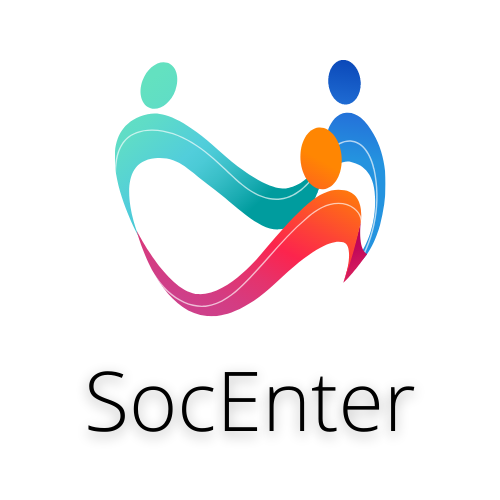Research commissioned by the Zofia Zamenhof Foundation as part of the SocEnter project
We would like to present to you the results of qualitative research conducted for the Zofia Zamenhof Foundation as part of the SocEnter project. The study is entitled “Characteristics of selected social cooperatives in the Mazowieckie Voivodeship and the contexts of their establishment”. The research sample was determined by purposeful selection in such a way as to choose as different organizations as possible to ensure the most extensive results. In the report below, you will find information on the situation of social cooperatives in Poland, the characteristics of the cooperatives surveyed, a description of the conditions for their establishment, a report on current activities, and the most important problems and difficulties they experience.
At the moment, the report is only available in Polish, but we will publish an English version soon. We invite all of you to read it!

In the framework of the Erasmus+ project SocEnter: Development of social entrepreneurship – new opportunities and ways of development, our school has carried out a survey aimed at adults and at people who work with adults, regardless of whether or not they are familiar with vertical companies.

Below is a video prepared by the Epralima social cooperative. As part of their activities, they run a gastronomic class, which also organizes social and sport activities aimed at improving the health and quality of life of the cooperative’s beneficiaries.

The latest activity of our Italian partner Centro Solidarietà Giovani
Below you will find a short text about mental and physical health from the perspective of people with disabilities. The text talks in detail about how you can develop programmes and exercises for disadvantaged groups in your community.

Developing Products and Services to Promote Healthy Lifestyles in Disadvantaged Communities
Introduction
Promoting healthy lifestyles in disadvantaged communities, particularly among disabled individuals, is essential for fostering equity and improving overall well-being. These communities often face unique challenges that necessitate tailored solutions. This chapter explores the strategies, principles, and best practices for developing products and services that effectively promote healthy lifestyles in such contexts.
Understanding the Needs of Disadvantaged Communities
- Community Assessment:
- Demographic Analysis: Understand the community’s composition, including types of disabilities, age groups, cultural backgrounds, and socio-economic status.
- Needs Assessment: Conduct surveys, focus groups, and interviews to identify specific health challenges, barriers to healthy living, and existing gaps in services.
- Inclusive Design Principles:
- Universal Design: Create products and services that are accessible and usable by all people, to the greatest extent possible, without the need for adaptation or specialized design.
- Participatory Design: Involve community members, especially those with disabilities, in the design process to ensure their needs and preferences are prioritized.
Developing Health-Promoting Products
- Assistive Technologies:
- Mobility Aids: Develop and provide access to affordable and durable mobility aids such as wheelchairs, walkers, and prosthetics that are tailored to individual needs.
- Health Monitoring Devices: Create user-friendly devices for monitoring vital signs, glucose levels, and other health metrics that can be easily used by disabled individuals.
- Nutrition and Food Access:
- Adaptive Cooking Tools: Design kitchen tools that accommodate various disabilities, such as easy-grip utensils and accessible cooking appliances.
- Healthy Meal Delivery Services: Establish programs that deliver nutritious meals tailored to dietary needs and preferences, ensuring they are affordable and accessible.
- Exercise and Physical Activity:
- Adaptive Fitness Equipment: Develop exercise equipment that can be used by individuals with various physical limitations, ensuring safety and ease of use.
- Inclusive Sports Programs: Create and support community sports programs that include adaptive sports, ensuring participation opportunities for all abilities.
Developing Health-Promoting Services
One-Day Physical Training Plan for Disabled People
Objective: To provide a comprehensive and accessible physical training routine that enhances cardiovascular health, strength, flexibility, and overall well-being for individuals with disabilities.
During the meetings, we prepared and conducted exercises for disabled people, and everyone participated in them willingly. Below is a description of one of the days of exercises that we conducted at CUS Drobin.
Duration: 1 hour and 20 minutes
1. Warm-Up Routine (10 minutes)
Purpose: The warm-up routine is designed to prepare the body for physical activity by gradually increasing heart rate and blood flow to muscles, which helps reduce the risk of injury and improve performance.
- Gentle Stretching:
- Neck Stretches: Slowly move your head side to side and front to back, holding each position for a few seconds. This helps loosen the neck muscles.
- Shoulder Rolls: Roll your shoulders forward and backward to release tension in the shoulder muscles.
- Arm Circles: Start with small circles and gradually increase the size to warm up the shoulder joints.
- Range of Motion Exercises:
- Wrist Rotations: Rotate your wrists in both directions to prepare them for upcoming exercises.
- Ankle Circles (if applicable): Rotate your ankles to enhance flexibility and prevent stiffness.
- Breathing Exercises:
- Deep Breathing: Inhale deeply through your nose, hold for a few seconds, and exhale slowly through your mouth. This helps oxygenate your muscles and calm your mind.
2. Cardiovascular Exercise (20 minutes)
Purpose: Cardiovascular exercises improve heart health, stamina, and energy levels. These exercises are tailored to accommodate various physical abilities.
- Wheelchair Aerobics:
- Arm Pushes: Push your arms forward and pull them back in a rhythmic motion to increase heart rate and strengthen arm muscles.
- Seated Marching: Lift your knees alternately as if marching while seated. This helps improve lower body circulation.
- Hand Cycling: Use resistance bands or an arm ergometer to simulate cycling movements, enhancing cardiovascular fitness.
3. Strength Training (30 minutes)
Purpose: Strength training exercises aim to enhance muscle strength, endurance, and functional ability, which are crucial for daily activities and overall health.
- Upper Body Exercises:
- Resistance Band Chest Presses: Hold the resistance band at chest level and press forward, engaging chest and arm muscles.
- Dumbbell Bicep Curls: Use light weights to curl your arms, focusing on bicep strength.
- Wheelchair Push-Ups (if possible): Perform push-ups using the wheelchair’s armrests to strengthen upper body muscles.
- Core Exercises:
- Seated Abdominal Crunches: Engage your core muscles by performing crunches while seated.
- Medicine Ball Twists: Hold a light ball and twist your torso side to side, targeting the oblique muscles.
4. Flexibility and Stretching (10 minutes)
Purpose: Flexibility exercises help increase range of motion, reduce muscle tension, and improve overall flexibility.
- Static Stretching:
- Triceps Stretch: Raise one arm overhead, bend the elbow, and use the opposite hand to gently pull the elbow for a deeper stretch.
- Seated Hamstring Stretch: Reach towards your toes while seated, stretching the hamstring muscles.
- Seated Torso Twist: Turn your upper body to each side, holding the position to stretch the torso and improve spinal mobility.
5. Balance and Coordination (10 minutes)
Purpose: Balance and coordination exercises improve stability and coordination, which are essential for performing daily activities and preventing falls.
- Seated Balance Exercises:
- Stability Ball or Firm Chair: Sit and lift one foot off the ground, maintaining balance. This strengthens core muscles and enhances stability.
- Catch and Throw a Lightweight Ball: Work with a partner or against a wall to improve hand-eye coordination and reflexes.
6. Cool Down Routine (10 minutes)
Purpose: The cool-down routine helps gradually lower heart rate, promotes relaxation, and prevents muscle stiffness.
- Gentle Stretching:
- Neck Stretches: Repeat the gentle neck stretches performed during the warm-up to release any remaining tension.
- Shoulder Rolls: Perform shoulder rolls again to ensure the muscles are relaxed.
- Arm Circles: Repeat arm circles to cool down the shoulder joints.
- Breathing Exercises:
- Deep Breathing: Continue deep breathing exercises to help your body transition from exercise to rest.
- Progressive Muscle Relaxation: Tense each muscle group for a few seconds, then release to promote full-body relaxation.
Notes
- Adjust the intensity and duration of exercises based on individual capabilities and fitness levels.
- Ensure proper hydration throughout the training session.
- Use adaptive equipment as needed to facilitate exercises.
- Consult with a healthcare professional or physical therapist before starting any new exercise routine, especially for those with specific medical conditions or limitations.
Physical health – the proper functioning of the body, its systems and organs. Physical health also talks about the balance between anabolic processes (creation) and catabolic (decomposition). We consider the body to be physically healthy when it is not pathological processes (diseases) occur in it. Its systems then work correctly. You don’t have to be very athletic to be able to say that you are physically healthy; in addition, older people also have a chance to maintain their status “physically healthy”, because old age is not a disease, although it is decreasing the efficiency of all human systems increases as the body ages it’s harder to stay fully healthy. It is worth adding that physical fitness is positive it also affects your mental condition.
Mental health – can be divided into two types – emotional health and wellness mental. An emotionally healthy person can recognize and name emotions. He can also express them in an appropriate way. It does so in accordance with the rules and standards social. Mental health also involves maintaining mental balance, and it includes emotion management – the ability to cope with stress, tension, anxiety, anger, aggression and other emotions. Mental Health and emotional can change over the course of a person’s life, but likewise physical health – is also genetically determined. Some people have it easier
become depressed or angry. Hence the idea for physical activities that help not only improve your fitness and fitness, but also help calm your thoughts, mental health and peace of mind.
- Healthcare Access:
- Mobile Clinics: Implement mobile health clinics that bring medical services directly to disadvantaged communities, reducing travel barriers.
- Telehealth Services: Expand telehealth offerings to provide remote consultations, therapy sessions, and follow-up care, ensuring accessibility features are in place.
- Education and Awareness:
- Health Literacy Programs: Develop educational programs that focus on health literacy, teaching community members about nutrition, exercise, disease prevention, and self-care.
- Workshops and Support Groups: Organize workshops and support groups tailored to the needs of disabled individuals, providing peer support and expert guidance on health-related topics.
- Community Engagement and Empowerment:
- Community Health Workers: Train and employ community health workers from within the community to act as liaisons, educators, and advocates.
- Participatory Action Research: Engage community members in research projects aimed at identifying health challenges and co-creating solutions, ensuring their voices are heard and valued.
Leveraging Technology and Innovation
- Digital Platforms:
- Mobile Apps: Develop mobile applications that offer health tracking, telehealth access, and educational resources, ensuring they are designed with accessibility in mind.
- Online Communities: Create online forums and social media groups where community members can share experiences, seek advice, and offer support.
- Data-Driven Approaches:
- Big Data Analytics: Utilize data analytics to identify health trends, measure the impact of interventions, and tailor services to better meet community needs.
- Personalization: Leverage AI and machine learning to provide personalized health recommendations and interventions based on individual data and preferences.
Policy and Advocacy
- Advocating for Inclusive Policies:
- Policy Engagement: Work with policymakers to advocate for inclusive health policies that address the specific needs of disabled individuals in disadvantaged communities.
- Funding and Support: Seek government and non-governmental funding to support health programs and ensure they are sustainable and scalable.
- Building Partnerships:
- Collaborations: Partner with local organizations, healthcare providers, and advocacy groups to enhance the reach and impact of health-promoting initiatives.
- Public-Private Partnerships: Engage in partnerships with private companies to leverage resources, technology, and expertise in developing health solutions.
Case Studies and Success Stories
- Successful Initiatives:
- Highlight case studies of successful health-promoting initiatives in disadvantaged communities, detailing the strategies used and the outcomes achieved.
- Lessons Learned:
- Discuss lessons learned from both successful and unsuccessful projects, offering insights into best practices and common pitfalls.
Conclusion
Developing products and services that promote healthy lifestyles in disadvantaged communities, particularly among disabled individuals, requires a multifaceted and inclusive approach. By understanding community needs, leveraging technology, advocating for inclusive policies, and fostering community engagement, we can create impactful solutions that improve health outcomes and enhance quality of life for all.
References
- https://mariuszsurma.com/oferta/trening-dla-osob-niepelnosprawnych/
- https://cus-drobin.pl
- https://www.ekonomiaspoleczna.gov.pl/czym-jest-ekonomia-spoleczna/
- https://www.helpguide.org/articles/healthy-living/chair-exercises-and-limited-mobility-fitness.htm
- https://www.mentalhealth.org.uk/explore-mental-health/a-z-topics/physical-health-and-mental-health
